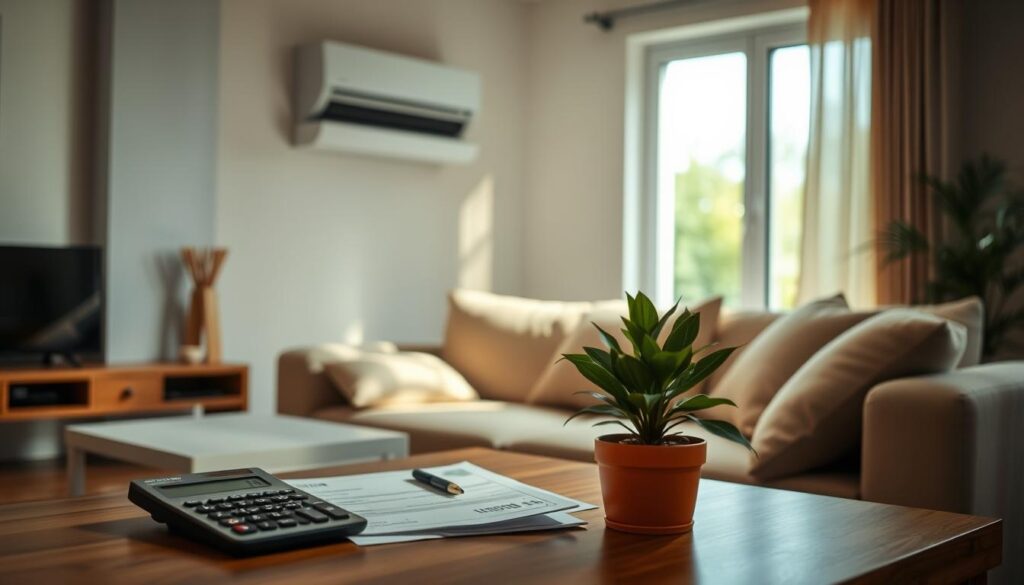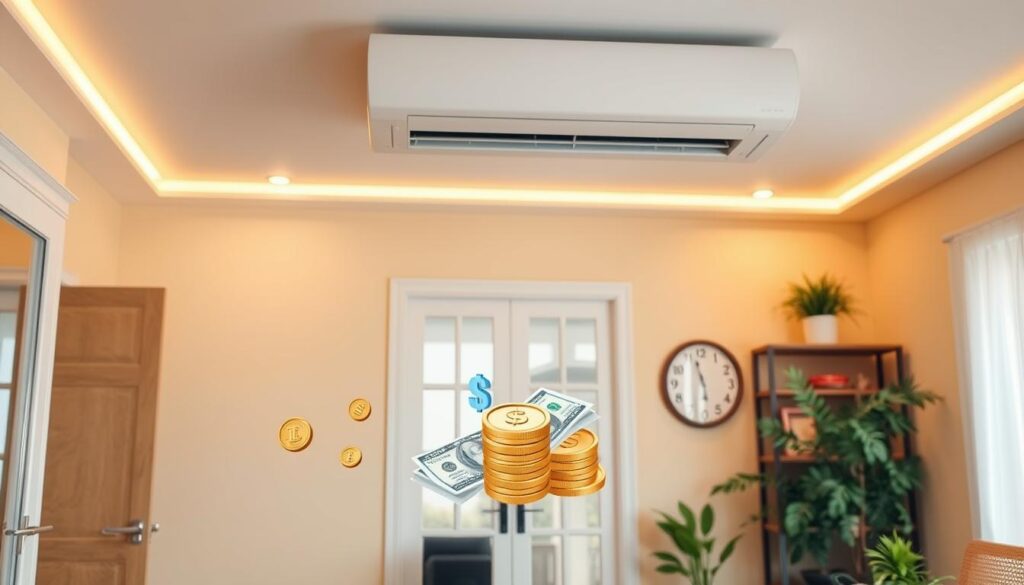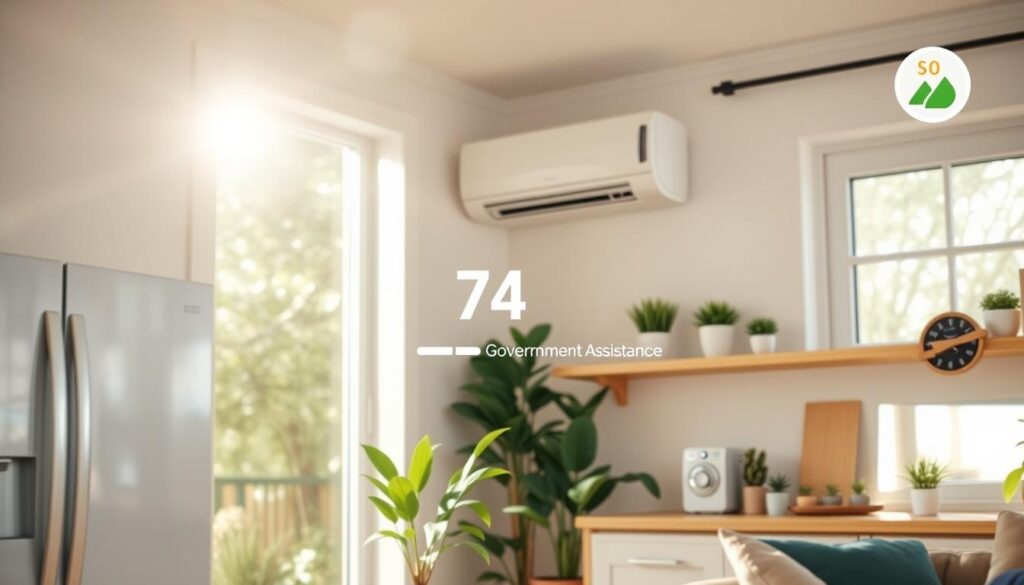Affiliate Disclosure
HVAC Guide Guys is a participant in the Amazon Services LLC Associates Program, an affiliate advertising program designed to provide a means for sites to earn advertising fees by advertising and linking to Amazon.
Can t Afford New HVAC? Replacing your HVAC system can cost between $3,000 and $10,000. This is a big expense for many homeowners. But, you don’t have to worry about the high cost. There are financing options that can make it more affordable, even if you have bad credit or limited funds.

There are many ways to finance your new HVAC system. You can look into personal loans, home equity financing, or even payment plans from HVAC companies. Knowing your options can help you stay comfortable at home without breaking the bank.
Key Takeaways
- HVAC systems can cost $3,000 to $10,000 to replace, a significant investment for many homeowners.
- Financing options are available for those who can’t afford the full cost upfront, including personal loans, home equity financing, and payment plans.
- HVAC company financing, government assistance programs, and energy efficiency initiatives can also help make a new system more affordable.
- Exploring various payment solutions is key to finding the best fit for your financial situation and home needs.
- Investing in a new, energy-efficient HVAC system can save money in the long run through reduced energy bills.
Table of Contents
Understanding HVAC System Replacement Costs
Replacing your HVAC system is a big deal. It keeps your home comfy and energy-smart. The cost can change a lot, based on different things. Knowing the average costs and hidden fees is key.
Average Cost Ranges for Different Systems
The price to replace your HVAC can be from $6,000 for a single unit to $34,000 for a whole new system without warranty. On average, it’s about $7 per square foot of your home for a full replacement.
Factors Affecting Total Installation Costs
Several things can change the cost of installing your new HVAC. These include:
- Condition of existing ductwork
- Energy efficiency ratings of the new system
- Labor costs in your local area
- Necessary upgrades to meet current building codes
Hidden Expenses to Consider
There are also hidden expenses to think about. These include:
- Permits and inspections
- Potential structural modifications to accommodate the new equipment
- Disposal of the old HVAC system
Getting a detailed estimate from a skilled HVAC contractor is crucial. They can look at your specific needs and give a clear cost breakdown.
“ENERGY STAR recommends replacing HVAC systems every 10 to 15 years to maintain optimal efficiency and performance.”
Knowing the average costs and what can change them helps homeowners plan. They can also look into financing options that fit their budget.
Explore Our HVAC Shop
Looking for top-rated HVAC tools, parts, and accessories? Visit our shop and find the perfect solution for your needs.
Visit the ShopCan t Afford New HVAC: Common Financial Challenges
Replacing an HVAC system can be very expensive for many homeowners. This is especially true when the old system breaks down unexpectedly. Limited savings and tight budgets make it hard to pay for a new system all at once. Knowing these HVAC affordability challenges is the first step to finding ways to finance a new system.
The high cost of replacing an HVAC system is a big problem. The average cost for a new central AC unit is up to $8,000. This is a lot for many families with budget constraints. Many homeowners in the US are putting off needed HVAC upgrades because of the cost.
There are also hidden costs that can increase the financial burden. These include the cost of making changes to your home, getting rid of the old system, and any permits or inspections needed. It’s important for homeowners to know about these extra costs to plan their budget correctly.
- High upfront costs of HVAC system replacement, often reaching $8,000 or more
- Limited household savings and tight budgets make it difficult to afford a new system
- Hidden expenses, such as home modifications, disposal, and permits, can further strain the budget
- Many homeowners are delaying necessary HVAC upgrades due to the financial burden
It’s important for homeowners facing HVAC replacement needs to understand these financial challenges. By knowing what obstacles they might face, they can prepare better. This way, they can explore financing options to make the replacement process easier.
Explore Our HVAC Shop
Looking for top-rated HVAC tools, parts, and accessories? Visit our shop and find the perfect solution for your needs.
Visit the ShopExploring HVAC Company Financing Options
Replacing an old or inefficient HVAC system can be expensive. Luckily, many HVAC companies offer financing to help. They have in-house financing, special deals, and flexible payment plans to fit your budget.
In-House Financing Programs
Many HVAC companies work with banks to offer financing. These plans have good interest rates and let you pay over time, up to 60 months. The application is usually fast, and some companies can decide right away.
Special Promotional Offers
Some companies offer special deals to encourage you to replace your HVAC. These might include no payments for a while or zero-interest periods. But, make sure to read the fine print to know the details.
Payment Plans and Terms
HVAC companies offer flexible payment plans. You might pay a little each month or pay off the loan without interest if you do it quickly. The terms and rates vary, so shop around to find the best deal.
Looking into HVAC financing can help you upgrade your home’s climate control without a huge upfront cost. Take your time to compare each offer to find the one that suits you best.
Personal Loan Solutions for HVAC Replacement
Replacing your HVAC system can be a big challenge. Personal loans are a good option. They offer fixed interest rates and flexible repayment terms. This makes them a great choice for covering the costs of a new HVAC system.
To apply for a personal loan, you’ll need to share some personal and financial details. This includes your credit history, income, and how much debt you have. Lenders use this info to decide if you qualify for a loan and what terms you’ll get.
Looking for the best personal loan for your HVAC needs? It’s smart to compare offers from different lenders. Look for low interest rates, flexible repayment plans, and few fees. Some lenders might offer special deals or lower rates to help you out.
| Loan Feature | Range |
|---|---|
| Loan Amounts | $1,000 to $100,000 |
| Interest Rates | 6.99% to 35.99% APR |
| Repayment Terms | 2 to 7 years |
| Minimum Credit Score | 580 to 660 |
| Origination Fees | 0% to 10% of loan amount |
Personal loans can be a good way to finance your HVAC replacement. But, make sure the loan fits your financial plans. By looking into personal loans for HVAC, bank financing, and credit union loans, you can find the right option for you.

Explore Our HVAC Shop
Looking for top-rated HVAC tools, parts, and accessories? Visit our shop and find the perfect solution for your needs.
Visit the ShopHome Equity and HELOC Financing Options
Owning a home can unlock valuable financial resources for financing a new HVAC system. Home equity loans and Home Equity Lines of Credit (HELOCs) let you borrow against your home’s equity.
Benefits of Using Home Equity
Home equity financing has many benefits. These include:
- Potentially lower interest rates than unsecured loans
- Potential tax deductions on the interest paid (consult a tax professional)
- Longer repayment terms, which can make monthly payments more manageable
- Access to larger loan amounts to cover the full cost of an HVAC replacement
Understanding HELOC Terms
A Home Equity Line of Credit (HELOC) gives homeowners a flexible line of credit. It’s secured by your home’s equity. Unlike a fixed repayment schedule, a HELOC lets you borrow as needed and repay over time.
Application Requirements
To get a home equity loan or HELOC, you’ll need to show proof of income. You’ll also need to pass a credit check and have your home appraised. Lenders use this info to figure out if you qualify and how much you can borrow.
Using your home’s equity can help you finance a new HVAC system. You might get lower interest rates and more flexible repayment options. This is better than using personal loans or credit cards.
Government Assistance and Energy Efficiency Programs
If you’re finding it hard to afford a new HVAC system, look into government help and energy-saving programs. These can make it easier to get a more efficient system without spending too much.
HVAC Government Assistance Programs
The Low Income Home Energy Assistance Program (LIHEAP) is a federal program. It helps low-income families with heating and cooling costs, including new HVAC systems. You might get help through the Regular HEAP Benefit, Emergency HEAP Benefit, or Heating Equipment Repair and Replacement (HERR) Benefit, based on your income and family size.
Energy Efficiency Rebates and Incentives
There are also rebates and incentives from state and local utilities for energy-saving HVAC upgrades. You might get tax credits, cash back, or lower installation costs. Check what’s available in your area to save more.
| Program | Benefit Details | Eligibility Criteria |
|---|---|---|
| Regular HEAP Benefit | Covers heating costs, opens Nov 1, 2024 | Income, household size, primary heating source |
| Emergency HEAP Benefit | First and Second Emergency Benefits, opens Jan 2, 2025 | Income, heating crisis, SNAP/TA/SSI |
| Clean and Tune Benefit | Up to $500 for energy efficiency services, opens Oct 1, 2024 | Homeowner, old heating equipment |
| HERR Benefit | Up to $4,000 for repair, $8,000 for replacement, opens Oct 1, 2024 | Income, heating equipment condition |
| Cooling Assistance Benefit | Up to $800 for AC/fan, $1,000 for wall sleeve, opens Apr 15, 2025 | Income, household with young/elderly/disabled |
Using these government and energy-saving programs can make upgrading your HVAC system easier. It helps keep your home comfortable and energy-efficient for a long time.

Explore Our HVAC Shop
Looking for top-rated HVAC tools, parts, and accessories? Visit our shop and find the perfect solution for your needs.
Visit the ShopCredit Card Financing and Special Programs
Replacing your HVAC system can be expensive. Credit card financing might help. Many cards offer “zero interest” deals for 12 to 18 months. This lets you pay over time without extra interest.
Zero Interest Promotions
Zero interest promotions are a big deal for HVAC financing. They let you pay without extra charges for a set time. But, remember, the regular APR can jump up after the deal ends.
Credit Card Comparison Tips
When looking at credit cards for HVAC financing, consider a few things:
- How long the zero interest deal lasts: Longer deals mean more time to pay without interest.
- The regular APR after the deal ends: Know the interest rate that kicks in later.
- Any fees on the card: Annual fees or other charges can add up.
By looking at these points, you can pick the best credit card for your HVAC needs and budget.
“Financing an HVAC system can be advantageous for spreading out costs over time and avoiding a large upfront payment.”
Options for Homeowners with Low Credit Scores
If you’re a homeowner with a low credit score, don’t worry. There are still ways to get financing for your HVAC needs. Even if traditional lenders say no, special programs and alternative lenders can help.
Look into bad credit HVAC financing options from HVAC companies. These plans are designed for those with lower credit scores. Some HVAC companies even offer rent-to-own or leasing options that don’t check your credit.
- PACE (Property Assessed Clean Energy) financing is a good choice. It doesn’t check your credit and can fund energy-efficient home improvements like HVAC systems.
- Home Run Financing offers low credit score options for financing furnaces, boilers, and more. They don’t look at your credit score.
- Geothermal and air source heat pumps are alternative HVAC funding options. They work as both heating and cooling systems.
Interest rates might be higher for those with bad credit. But these options can still help you get the HVAC system your home needs. Making timely payments can also improve your credit score over time.
“Financing a new HVAC system shouldn’t be a barrier for homeowners with low credit. There are solutions out there that can help, even if traditional lenders have turned you down.”
Don’t let a low credit score stop you from upgrading your HVAC system. Look into the different bad credit HVAC financing, low credit score options, and alternative HVAC funding choices. Find the best one for your home and budget.
Explore Our HVAC Shop
Looking for top-rated HVAC tools, parts, and accessories? Visit our shop and find the perfect solution for your needs.
Visit the ShopWeatherization Assistance Programs and Grants
If you’re finding it hard to afford a new HVAC system, there’s help available. Government-backed programs and grants can offer financial relief. They aim to make homes more energy-efficient and lower utility bills for low-income families.
LIHEAP Benefits
The Low-Income Home Energy Assistance Program (LIHEAP) helps with heating and cooling costs. In some places, it covers the cost of HVAC repairs or new systems. This support is crucial for older adults and families in need.
State-Specific Programs
- States like Mississippi, Nebraska, Kentucky, North Carolina, and Texas offer free fan programs. These help vulnerable residents stay cool during hot weather.
- In cities like Fort Worth, Texas, Baton Rouge, Louisiana, and Bartlesville, Oklahoma, organizations donate air conditioners. They help older adults who can’t afford them.
- Cooling stations in towns and cities provide air-conditioned spaces. They are often set up by local Area Agencies on Aging.
To find more financial help, use the National Council on Aging’s BenefitsCheckUp.org tool. It’s a great resource for finding programs in your area.
Weatherization Assistance Program (WAP)
The Weatherization Assistance Program (WAP) is the biggest program in the U.S. It helps low-income families make their homes more energy-efficient. This includes upgrading HVAC systems for free for those who qualify.
This program not only saves money on energy but also improves health and well-being. It’s a win-win for everyone involved.
| Weatherization Assistance Program (WAP) Key Facts | Impacts |
|---|---|
| Funded by Federal, State Governments, and Local Utilities | $2.78 in nonenergy benefits for every $1.00 invested |
| Eligible for assistance once every 15 years | $283 average annual energy savings per household |
| Measures include sealing gaps, adding insulation, and repairing/replacing heating systems | 18% annual heating consumption savings, 7% annual electric consumption savings |
By using HVAC assistance programs and weatherization grants, you can make your home more energy-efficient. This could save you hundreds of dollars on utility bills each year. Look into what’s available in your state to see how LIHEAP and other programs can help you afford a new HVAC system.
Energy-Efficient HVAC Investment Benefits
When you need to replace your HVAC system, think about the long-term gains of an energy-efficient model. These systems use less energy and can cut down your energy-efficient HVAC savings on bills.
The U.S. Department of Energy says a high-efficiency HVAC can cut your monthly bills by 20-40%. They also suggest replacing your system every 10-15 years. This keeps your HVAC efficiency benefits high and energy costs low.
Energy-efficient HVACs have more than just cost savings. They also reduce your carbon footprint, improve air quality, and control temperature better. This means better comfort for you.
Many HVAC companies offer financing to help with the cost. You might also get government incentives, tax credits, or rebates for energy-efficient HVAC savings. With regular maintenance, these systems keep saving you money for years.
When looking at new HVACs, choose ones with high SEER or AFUE ratings. This will help you save more money in the long run. Also, get a professional to install it for the best performance.
“Investing in an energy-efficient HVAC system can reduce energy consumption by up to 50%, resulting in significant savings on utility bills.”
Choosing energy efficiency means you get benefits right away and save money for years. It’s good for your home and the planet.
Conclusion
Replacing your HVAC system doesn’t have to be expensive. You have many HVAC financing options to choose from. This includes HVAC company financing, personal loans, government help, and energy savings programs.
Look at each affordable HVAC solution carefully. Think about the long-term benefits. Pick the financing that suits your budget and needs best. This could be a payment plan, a home equity loan, or a special deal.
Choosing the right financing is key. It helps you get a new HVAC system without spending too much. Working with a reliable HVAC contractor is also important. They can help you find the best system for your home and get any discounts or incentives.

